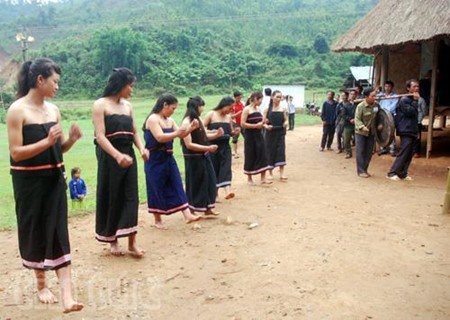(VOVworld) – The Gie Trieng, one of 6 tribes in Kon Tum province, has about 33,000 people. They live in Dak Glei and Ngoc Hoi district along the Ho Chi Minh trail near the border with Laos. Like other ethnic groups in Vietnam, the Gie Trieng have a distinct culture and have contributed to national construction.
 |
Gie Trieng women dance their traditional Xoang in front of the Rong house (Photo: Viet Ton)
|
Gie Trieng villages span the Vietnam-Laos border from Dak Glei to Ngoc Hoi district in Kon Tum province. A village is led by a patriarch, a respected man with profound knowledge of the group’s history, culture, and lifestyle.
The Gie Trieng are polytheists and believe that all things have souls and that the Jade Emperor has the supreme power to control everything. They have several rituals for worshiping the Jade Emperor, the communal house, and new rice. Recently certain ancient customs like hanging coffins have been abandoned.
 |
A Gie Trieng plays the gong
|
A Be, a Gie Trieng man in Dak Duc commune, Ngoc Hoi district, said: “In the past, the Gie Trieng were superstitious. This means, for example, when the family had unexpected bad luck such as an animal or someone in the family dying, they would abstain from some activity for a period of time. Such superstitions have largely been abandoned.”
While working to improve their living conditions, the Gie Trieng have also tried to presser their traditional culture. Every village has a Rong communal house for community meetings. Dương Tôn Bảo, a researcher of Central Highlands culture, said: “The Gie Trieng have preserved many fine customs. For example, there is a traditional performance by 6 men wearing women’s clothes and playing a musical instrument called the Dinh Tut. They have rituals to celebrate a new Rong house, a new rice crop, or a newborn baby.”
Since Kon Tum province was reestablished in 1991, the life of the Gie Trieng has improved. The construction of the Ho Chi Minh trail enabled Gie Trieng people to expand trade and production. They grow rice and other cash crops such as rubber and coffee. Many families have become better-off.
The Gie Trieng use their own Mon-Khmer language alongside Vietnamese. In their villages, concrete houses are built next to ancient stilt houses. They have cars, motorbikes, refrigerators, and gas cookers, but still use traditional wood stoves and produce bamboo containers for daily use.